Abstract
To further the development and application of exposure markers in field investigations in reproductive epidemiology, we have synthesized recent examinations of the issues surrounding exposure measurements in reproductive epidemiology. The specific goals of this paper are to define exposure biomarkers and explore their potential uses, particularly as screening tools. The tests for glucaric acid, thioethers, mutagenicity, and porphyrin patterns meet the general criteria for useful exposure screens. For certain xenobiotic agents, these tests accurately differentiate exposure levels, as demonstrated in occupational and environmental epidemiologic studies. As urinary screens, they are noninvasive and applicable on a large scale with current laboratory techniques. For short-term exposure, glucaric acid, thioethers, and mutagenicity tests are useful. Porphyrin patterns may measure cumulative effects as well as current exposure levels. The usefulness of these tests in epidemiologic studies of environmental effects on reproductive health has yet to be studied. To do so, the battery must be standardized for pregnant women, and test results must be correlated with measured adverse reproductive outcomes, such as gestational length and birthweight. This correlation is particularly important because maternal exposure rather than fetal exposure is being measured. The extent to which xenobiotic chemicals cross the placental barrier may vary greatly depending on the type of exposures, timing in pregnancy, and maternal detoxification capability. Without better exposure measures, epidemiologic studies of reproductive health probably will not successfully identify xenobiotic fetotoxic agents in the environment. However, with an adequate battery of nonspecific exposure biomarkers, prospective studies of environmental effects on pregnancy outcomes might be possible.(ABSTRACT TRUNCATED AT 250 WORDS)
Full text
PDF

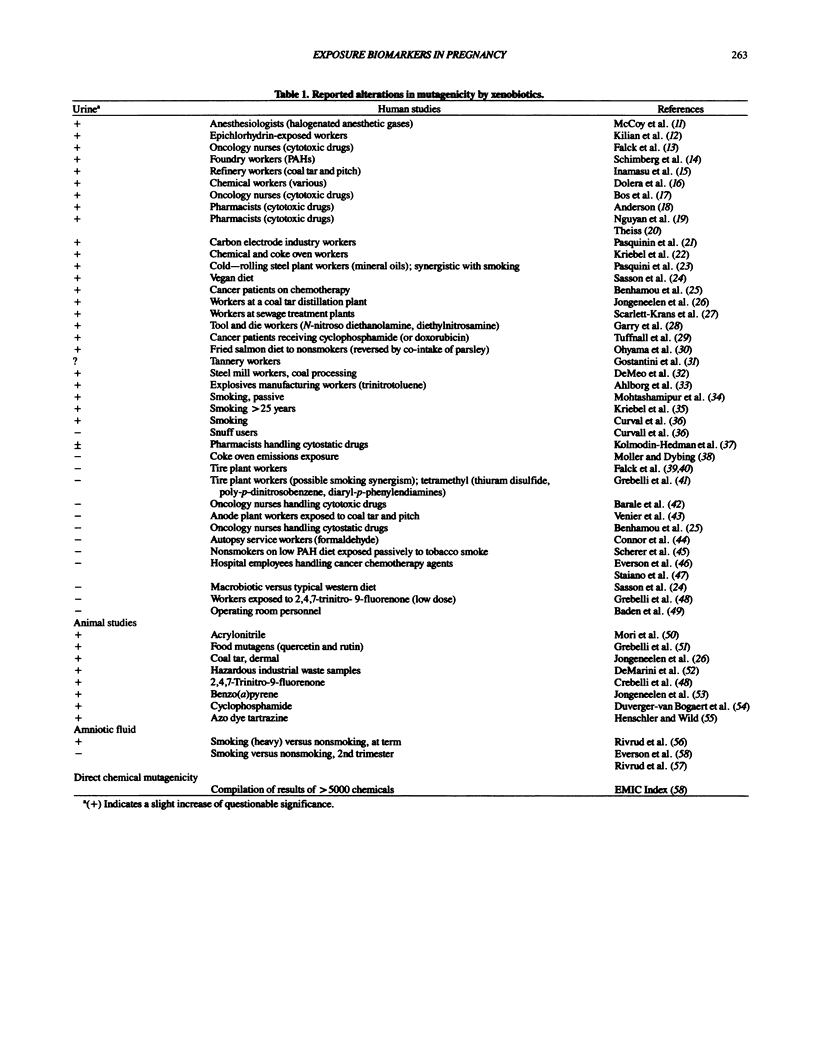
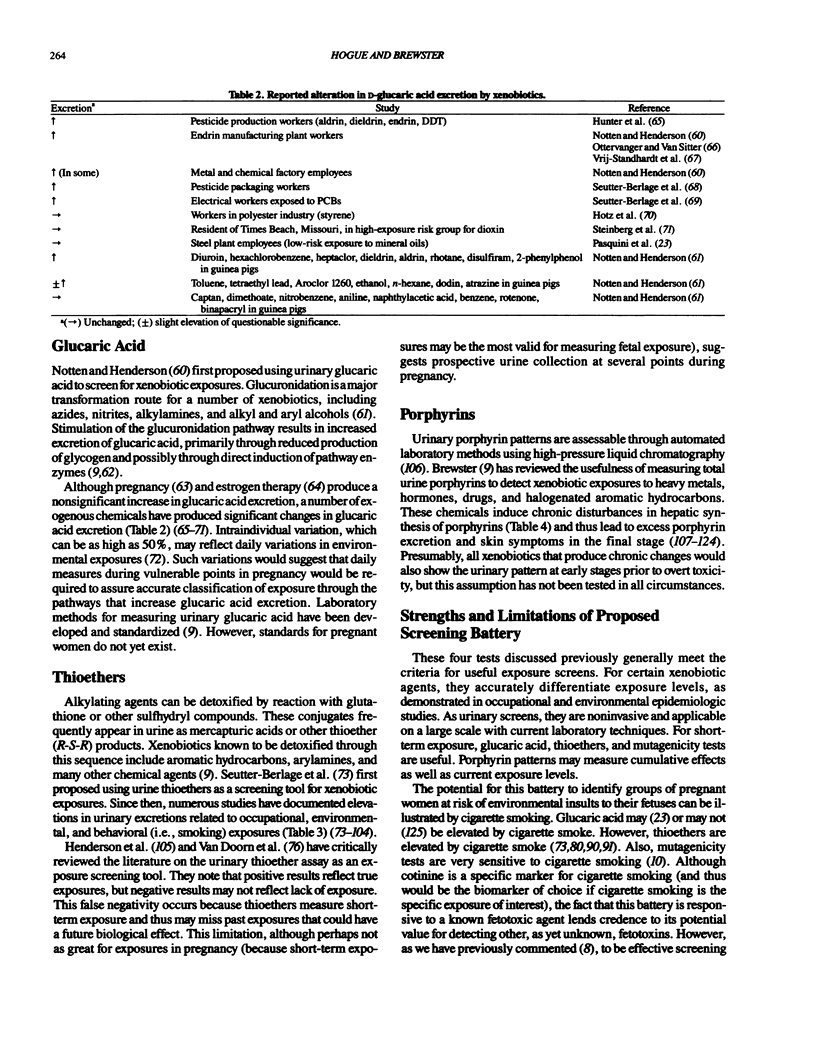

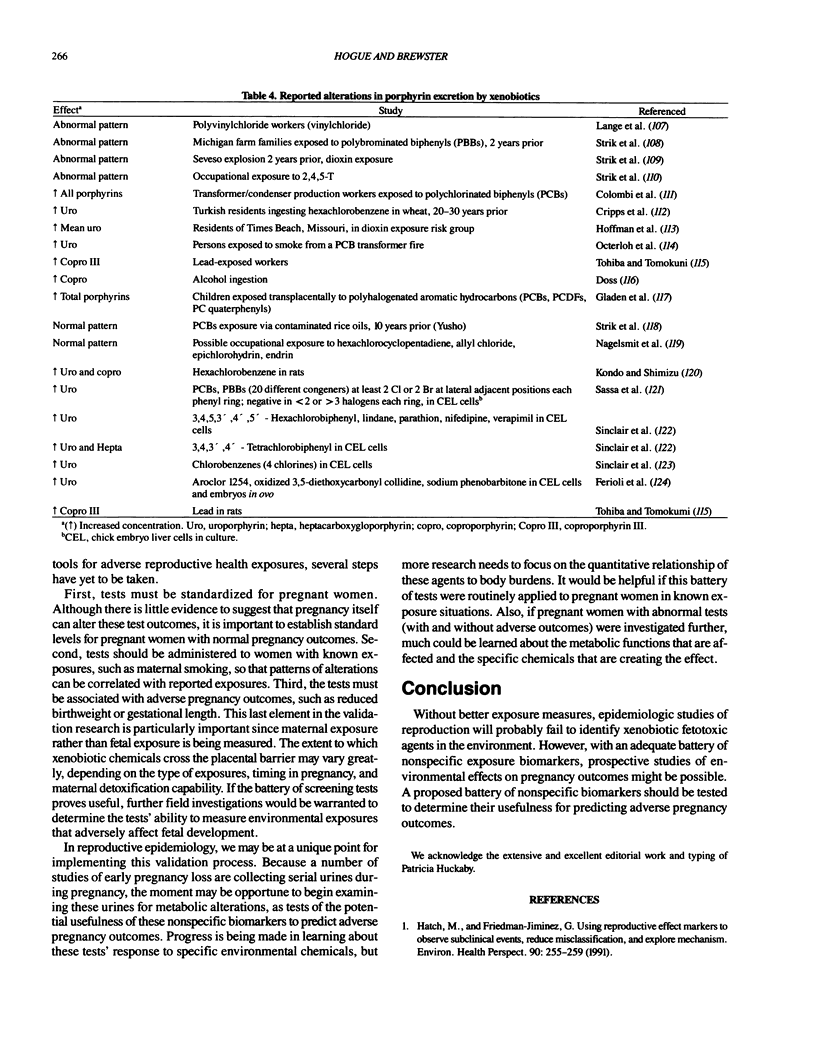

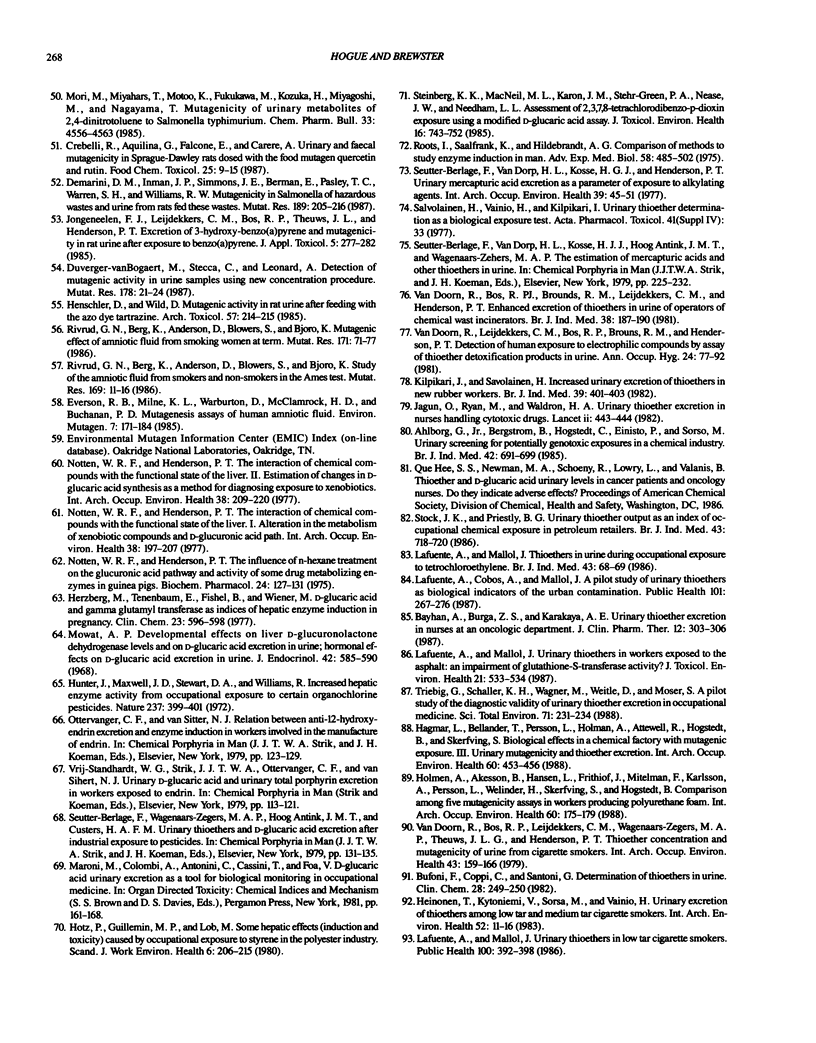
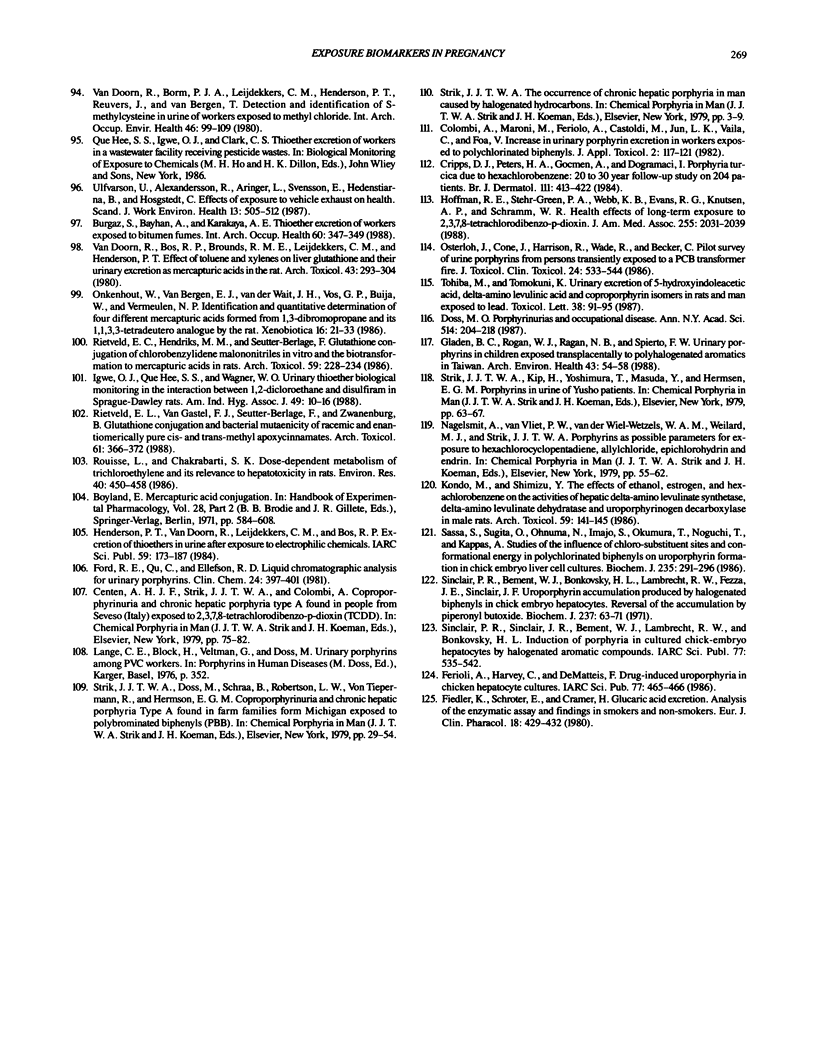
Selected References
These references are in PubMed. This may not be the complete list of references from this article.
- Ahlborg G., Jr, Bergström B., Hogstedt C., Einistö P., Sorsa M. Urinary screening for potentially genotoxic exposures in a chemical industry. Br J Ind Med. 1985 Oct;42(10):691–699. doi: 10.1136/oem.42.10.691. [DOI] [PMC free article] [PubMed] [Google Scholar]
- Ahlborg G., Jr, Einistö P., Sorsa M. Mutagenic activity and metabolites in the urine of workers exposed to trinitrotoluene (TNT). Br J Ind Med. 1988 May;45(5):353–358. doi: 10.1136/oem.45.5.353. [DOI] [PMC free article] [PubMed] [Google Scholar]
- Anderson R. W., Puckett W. H., Jr, Dana W. J., Nguyen T. V., Theiss J. C., Matney T. S. Risk of handling injectable antineoplastic agents. Am J Hosp Pharm. 1982 Nov;39(11):1881–1887. [PubMed] [Google Scholar]
- Baden J. M., Kelley M., Cheung A., Mortelmans K. Lack of mutagens in urines of operating room personnel. Anesthesiology. 1980 Sep;53(3):195–198. doi: 10.1097/00000542-198009000-00003. [DOI] [PubMed] [Google Scholar]
- Barale R., Sozzi G., Toniolo P., Borghi O., Reali D., Loprieno N., Della Porta G. Sister-chromatid exchanges in lymphocytes and mutagenicity in urine of nurses handling cytostatic drugs. Mutat Res. 1985 Aug-Sep;157(2-3):235–240. doi: 10.1016/0165-1218(85)90121-1. [DOI] [PubMed] [Google Scholar]
- Bayhan A., Burgaz S., Karakaya A. E. Urinary thioether excretion in nurses at an oncologic department. J Clin Pharm Ther. 1987 Oct;12(5):303–306. doi: 10.1111/j.1365-2710.1987.tb00541.x. [DOI] [PubMed] [Google Scholar]
- Benhamou S., Callais F., Sancho-Garnier H., Min S., Courtois Y. A., Festy B. Mutagenicity in urine from nurses handling cytostatic agents. Eur J Cancer Clin Oncol. 1986 Dec;22(12):1489–1493. doi: 10.1016/0277-5379(86)90085-4. [DOI] [PubMed] [Google Scholar]
- Bos R. P., Leenaars A. O., Theuws J. L., Henderson P. T. Mutagenicity of urine from nurses handling cytostatic drugs, influence of smoking. Int Arch Occup Environ Health. 1982;50(4):359–369. doi: 10.1007/BF00377832. [DOI] [PubMed] [Google Scholar]
- Brewster M. A. Biomarkers of xenobiotic exposures. Ann Clin Lab Sci. 1988 Jul-Aug;18(4):306–317. [PubMed] [Google Scholar]
- Brunekreef B., Noy D., Clausing P. Variability of exposure measurements in environmental epidemiology. Am J Epidemiol. 1987 May;125(5):892–898. doi: 10.1093/oxfordjournals.aje.a114606. [DOI] [PubMed] [Google Scholar]
- Buffoni F., Coppi C., Santoni G. Determination of thioethers in urine. Clin Chem. 1982 Jan;28(1):248–250. [PubMed] [Google Scholar]
- Burgaz S., Bayhan A., Karakaya A. E. Thioether excretion of workers exposed to bitumen fumes. Int Arch Occup Environ Health. 1988;60(5):347–349. doi: 10.1007/BF00405668. [DOI] [PubMed] [Google Scholar]
- Connor T. H., Ward J. B., Jr, Legator M. S. Absence of mutagenicity in the urine of autopsy service workers exposed to formaldehyde: factors influencing mutagenicity testing of urine. Int Arch Occup Environ Health. 1985;56(3):225–237. doi: 10.1007/BF00396600. [DOI] [PubMed] [Google Scholar]
- Costantini A. S., Paci E., Scala D., Cariaggi P., Cipparrone G., Confortini M., Maddau C., Buti R., Dolara P., Salvadori M. Monitoring of carcinogenic risks in tannery workers by means of desquamative lung and bladder cytology and urinary mutagenicity. Ann Occup Hyg. 1987;31(1):21–30. doi: 10.1093/annhyg/31.1.21. [DOI] [PubMed] [Google Scholar]
- Crebelli R., Aquilina G., Falcone E., Carere A., Caperle M., Crespi M., Zito R. Monitoring of urinary mutagenicity in workers exposed to low doses of 2,4,7-trinitro-9-fluorenone. Scand J Work Environ Health. 1985 Aug;11(4):295–300. doi: 10.5271/sjweh.2225. [DOI] [PubMed] [Google Scholar]
- Crebelli R., Aquilina G., Falcone E., Carere A. Urinary and faecal mutagenicity in Sprague-Dawley rats dosed with the food mutagens quercetin and rutin. Food Chem Toxicol. 1987 Jan;25(1):9–15. doi: 10.1016/0278-6915(87)90301-2. [DOI] [PubMed] [Google Scholar]
- Cripps D. J., Peters H. A., Gocmen A., Dogramici I. Porphyria turcica due to hexachlorobenzene: a 20 to 30 year follow-up study on 204 patients. Br J Dermatol. 1984 Oct;111(4):413–422. doi: 10.1111/j.1365-2133.1984.tb06603.x. [DOI] [PubMed] [Google Scholar]
- De Méo M. P., Duménil G., Botta A. H., Laget M., Zabaloueff V., Mathias A. Urine mutagenicity of steel workers exposed to coke oven emissions. Carcinogenesis. 1987 Mar;8(3):363–367. doi: 10.1093/carcin/8.3.363. [DOI] [PubMed] [Google Scholar]
- DeMarini D. M., Inmon J. P., Simmons J. E., Berman E., Pasley T. C., Warren S. H., Williams R. W. Mutagenicity in salmonella of hazardous wastes and urine from rats fed these wastes. Mutat Res. 1987 Nov;189(3):205–216. doi: 10.1016/0165-1218(87)90054-1. [DOI] [PubMed] [Google Scholar]
- Dolara P., Mazzoli S., Rosi D., Buiatti E., Baccetti S., Turchi A., Vannucci V. Exposure to carcinogenic chemicals and smoking increases urinary excretion of mutagens in humans. J Toxicol Environ Health. 1981 Jul-Aug;8(1-2):95–103. doi: 10.1080/15287398109530053. [DOI] [PubMed] [Google Scholar]
- Doss M. O. Porphyrinurias and occupational disease. Ann N Y Acad Sci. 1987;514:204–218. doi: 10.1111/j.1749-6632.1987.tb48775.x. [DOI] [PubMed] [Google Scholar]
- Duverger-van Bogaert M., Stecca C., Léonard A. Detection of mutagenic activity in urine samples using a new concentration procedure. Mutat Res. 1987 May;178(1):21–24. doi: 10.1016/0027-5107(87)90081-9. [DOI] [PubMed] [Google Scholar]
- Everson R. B., Milne K. L., Warburton D., McClamrock H. D., Buchanan P. D. Mutagenesis assays of human amniotic fluid. Environ Mutagen. 1985;7(2):171–184. doi: 10.1002/em.2860070206. [DOI] [PubMed] [Google Scholar]
- Everson R. B., Ratcliffe J. M., Flack P. M., Hoffman D. M., Watanabe A. S. Detection of low levels of urinary mutagen excretion by chemotherapy workers which was not related to occupational drug exposures. Cancer Res. 1985 Dec;45(12 Pt 1):6487–6497. [PubMed] [Google Scholar]
- Falck K. Biological monitoring of occupational exposure to mutagenic chemicals in the rubber industry. Use of the bacterial urinary mutagenicity assay. Scand J Work Environ Health. 1983;9 (Suppl 2):39–42. [PubMed] [Google Scholar]
- Falck K., Sorsa M., Vainio H., Kilpikari I. Mutagenicity in urine of workers in rubber industry. Mutat Res. 1980 Sep;79(1):45–52. doi: 10.1016/0165-1218(80)90146-9. [DOI] [PubMed] [Google Scholar]
- Fiedler K., Schröter E., Cramer H. Glucaric acid excretion. Analysis of the enzymatic assay and findings in smokers and non-smokers. Eur J Clin Pharmacol. 1980 Nov;18(5):429–432. doi: 10.1007/BF00636798. [DOI] [PubMed] [Google Scholar]
- Ford R. E., Ou C. N., Ellefson R. D. Liquid-chromatographic analysis for urinary porphyrins. Clin Chem. 1981 Mar;27(3):397–401. [PubMed] [Google Scholar]
- Garry V. F., Jacobs D. R., Kreiger R. A., Nelson R. L., Loeppky R., Harkins M. E. Integration of laboratory and epidemiologic studies to evaluate genotoxic exposure in tool and die workers. Prog Clin Biol Res. 1986;207:183–193. [PubMed] [Google Scholar]
- Gladen B. C., Rogan W. J., Ragan N. B., Spierto F. W. Urinary porphyrins in children exposed transplacentally to polyhalogenated aromatics in Taiwan. Arch Environ Health. 1988 Jan-Feb;43(1):54–58. doi: 10.1080/00039896.1988.9934374. [DOI] [PubMed] [Google Scholar]
- Hagmar L., Bellander T., Persson L., Holmén A., Attewell R., Högstedt B., Skerfving S. Biological effects in a chemical factory with mutagenic exposure. III. Urinary mutagenicity and thioether excretion. Int Arch Occup Environ Health. 1988;60(6):453–456. doi: 10.1007/BF00381394. [DOI] [PubMed] [Google Scholar]
- Hatch M. C., Friedman-Jimenez G. Using reproductive effect markers to observe subclinical events, reduce misclassification, and explore mechanism. Environ Health Perspect. 1991 Jan;90:255–259. doi: 10.1289/ehp.90-1519471. [DOI] [PMC free article] [PubMed] [Google Scholar]
- Heinonen T., Kytöniemi V., Sorsa M., Vainio H. Urinary excretion of thioethers among low-tar and medium-tar cigarette smokers. Int Arch Occup Environ Health. 1983;52(1):11–16. doi: 10.1007/BF00380602. [DOI] [PubMed] [Google Scholar]
- Henderson P. T., van Doorn R., Leijdekkers C. M., Bos R. P. Excretion of thioethers in urine after exposure to electrophilic chemicals. IARC Sci Publ. 1984;(59):173–187. [PubMed] [Google Scholar]
- Henschler D., Wild D. Mutagenic activity in rat urine after feeding with the azo dye tartrazine. Arch Toxicol. 1985 Aug;57(3):214–215. doi: 10.1007/BF00290891. [DOI] [PubMed] [Google Scholar]
- Herzberg M., Tenenbaum E., Fishel B., Wiener M. H. D-Glucaric acid and gamma-glutamyltransferase as indices of hepatic enzyme induction in pregnancy. Clin Chem. 1977 Mar;23(3):596–598. [PubMed] [Google Scholar]
- Hoffman R. E., Stehr-Green P. A., Webb K. B., Evans R. G., Knutsen A. P., Schramm W. F., Staake J. L., Gibson B. B., Steinberg K. K. Health effects of long-term exposure to 2,3,7,8-tetrachlorodibenzo-p-dioxin. JAMA. 1986 Apr 18;255(15):2031–2038. [PubMed] [Google Scholar]
- Holmén A., Akesson B., Hansén L., Frithiof J., Mitelman F., Karlsson A., Persson L., Welinder H., Skerfving S., Högstedt B. Comparison among five mutagenicity assays in workers producing polyurethane foams. Int Arch Occup Environ Health. 1988;60(3):175–179. doi: 10.1007/BF00378694. [DOI] [PubMed] [Google Scholar]
- Hotz P., Guillemin M. P., Lob M. Study of some hepatic effects (induction and toxicity) caused by occupational exposure to styrene in the polyester industry. Scand J Work Environ Health. 1980 Sep;6(3):206–215. doi: 10.5271/sjweh.2614. [DOI] [PubMed] [Google Scholar]
- Hulka B. S., Wilcosky T. Biological markers in epidemiologic research. Arch Environ Health. 1988 Mar-Apr;43(2):83–89. doi: 10.1080/00039896.1988.9935831. [DOI] [PubMed] [Google Scholar]
- Hulka B. S., Wilcosky T. Biological markers in epidemiologic research. Arch Environ Health. 1988 Mar-Apr;43(2):83–89. doi: 10.1080/00039896.1988.9935831. [DOI] [PubMed] [Google Scholar]
- Hunter J., Maxwell J. D., Stewart D. A., Williams R., Robinson J., Richardson A. Increased hepatic microsomal enzyme activity from occupational exposure to certain organochlorine pesticides. Nature. 1972 Jun 16;237(5355):399–401. doi: 10.1038/237399a0. [DOI] [PubMed] [Google Scholar]
- Igwe O. J., Que Hee S. S., Wagner W. D. Urinary thioether biological monitoring in the interaction between 1,2-dichloroethane and disulfiram in Sprague-Dawley rats. Am Ind Hyg Assoc J. 1988 Jan;49(1):10–16. doi: 10.1080/15298668891379297. [DOI] [PubMed] [Google Scholar]
- Inamasu T., Kitamori S., Ishizawa M., Hisanaga A. [A mutagenicity assay of urine of workers in a refinery (author's transl)]. Sangyo Igaku. 1981 Nov;23(6):640–641. doi: 10.1539/joh1959.23.640. [DOI] [PubMed] [Google Scholar]
- Jongeneelen F. J., Bos R. P., Anzion R. B., Theuws J. L., Henderson P. T. Biological monitoring of polycyclic aromatic hydrocarbons. Metabolites in urine. Scand J Work Environ Health. 1986 Apr;12(2):137–143. doi: 10.5271/sjweh.2166. [DOI] [PubMed] [Google Scholar]
- Jongeneelen F. J., Leijdekkers C. M., Bos R. P., Theuws J. L., Henderson P. T. Excretion of 3-hydroxy-benzo(a)pyrene and mutagenicity in rat urine after exposure to benzo(a)pyrene. J Appl Toxicol. 1985 Oct;5(5):277–282. doi: 10.1002/jat.2550050503. [DOI] [PubMed] [Google Scholar]
- Kilpikari I., Savolainen H. Increased urinary excretion of thioether in new rubber workers. Br J Ind Med. 1982 Nov;39(4):401–403. doi: 10.1136/oem.39.4.401. [DOI] [PMC free article] [PubMed] [Google Scholar]
- Kolmodin-Hedman B., Hartvig P., Sorsa M., Falck K. Occupational handling of cytostatic drugs. Arch Toxicol. 1983 Sep;54(1):25–33. doi: 10.1007/BF00277812. [DOI] [PubMed] [Google Scholar]
- Kondo M., Shimizu Y. The effects of ethanol, estrogen, and hexachlorobenzene on the activities of hepatic delta-aminolevulinate synthetase, delta-aminolevulinate dehydratase, and uroporphyrinogen decarboxylase in male rats. Arch Toxicol. 1986 Oct;59(3):141–145. doi: 10.1007/BF00316322. [DOI] [PubMed] [Google Scholar]
- Kriebel D., Commoner B., Bollinger D., Bronsdon A., Gold J., Henry J. Detection of occupational exposure to genotoxic agents with a urinary mutagen assay. Mutat Res. 1983 Mar;108(1-3):67–79. doi: 10.1016/0027-5107(83)90110-0. [DOI] [PubMed] [Google Scholar]
- Kriebel D., Henry J., Gold J. C., Bronsdon A., Commoner B. The mutagenicity of cigarette smokers' urine. J Environ Pathol Toxicol Oncol. 1985 Nov-Dec;6(2):157–169. [PubMed] [Google Scholar]
- Lafuente A., Cobos A., Mallol J. A pilot study of urinary thioethers as biological indicators of the urban contamination. Public Health. 1987 Jul;101(4):267–276. doi: 10.1016/s0033-3506(87)80077-x. [DOI] [PubMed] [Google Scholar]
- Lafuente A., Mallol J. Thioethers in urine during occupational exposure to tetrachloroethylene. Br J Ind Med. 1986 Jan;43(1):68–69. doi: 10.1136/oem.43.1.68. [DOI] [PMC free article] [PubMed] [Google Scholar]
- Lafuente A., Mallol J. Urinary thioethers in low tar cigarette smokers. Public Health. 1986 Nov;100(6):392–398. doi: 10.1016/s0033-3506(86)80102-0. [DOI] [PubMed] [Google Scholar]
- Lafuente A., Mallol J. Urinary thioethers in workers exposed to the asphalt: an impairment of glutathione S-transferase activity? J Toxicol Environ Health. 1987;21(4):533–534. doi: 10.1080/15287398709531041. [DOI] [PubMed] [Google Scholar]
- Longo L. D. Physiologic assessment of fetal compromise: biomarkers of toxic exposure. Environ Health Perspect. 1987 Oct;74:93–101. doi: 10.1289/ehp.877493. [DOI] [PMC free article] [PubMed] [Google Scholar]
- Macek C. Hospital personnel who handle anticancer drugs may face risks. JAMA. 1982 Jan 1;247(1):11–12. [PubMed] [Google Scholar]
- McCoy E. C., Hankel R., Rosenkranz H. S., Giuffrida J. G., Bizzari D. V. Detection of mutagenic activity in the urines of anesthesiologists: a preliminary report. Environ Health Perspect. 1977 Dec;21:221–223. doi: 10.1289/ehp.7721221. [DOI] [PMC free article] [PubMed] [Google Scholar]
- Mohtashamipur E., Müller G., Norpoth K., Endrikat M., Stücker W. Urinary excretion of mutagens in passive smokers. Toxicol Lett. 1987 Jan;35(1):141–146. doi: 10.1016/0378-4274(87)90099-3. [DOI] [PubMed] [Google Scholar]
- Mori M., Miyahara T., Moto-o K., Fukukawa M., Kozuka H., Miyagoshi M., Nagayama T. Mutagenicity of urinary metabolites of 2,4-dinitrotoluene to Salmonella typhimurium. Chem Pharm Bull (Tokyo) 1985 Oct;33(10):4556–4563. doi: 10.1248/cpb.33.4556. [DOI] [PubMed] [Google Scholar]
- Mowat A. P. Developmental effects on liver D-glucuronolactone dehydrogenase levels and on D-glucaric acid excretion in urine; hormonal effects on D-glucaric acid excretion in urine. J Endocrinol. 1968 Dec;42(4):585–590. doi: 10.1677/joe.0.0420585. [DOI] [PubMed] [Google Scholar]
- Møller M., Dybing E. Mutagenicity studies with urine concentrates from coke plant workers. Scand J Work Environ Health. 1980 Sep;6(3):216–220. doi: 10.5271/sjweh.2611. [DOI] [PubMed] [Google Scholar]
- Nguyen T. V., Theiss J. C., Matney T. S. Exposure of pharmacy personnel to mutagenic antineoplastic drugs. Cancer Res. 1982 Nov;42(11):4792–4796. [PubMed] [Google Scholar]
- Notten W. R., Henderson P. T. The influence of n-hexane treatment on the glucuronic acid pathway and activity of some drug-metabolizing enzymes in guinea-pig. Biochem Pharmacol. 1975 Jan 1;24(1):127–131. doi: 10.1016/0006-2952(75)90324-x. [DOI] [PubMed] [Google Scholar]
- Notten W. R., Henderson P. T. The interaction of chemical compounds with the functional state of the liver. I. Alterations in the metabolism of xenobiotic compounds and D-glucuronic acid pathway. Int Arch Occup Environ Health. 1977;38(3):197–207. doi: 10.1007/BF00378357. [DOI] [PubMed] [Google Scholar]
- Notten W. R., Henderson P. T. The interaction of chemical compounds with the functional state of the liver. II. Estimation of changes in D-glucaric acid synthesis as a method for diagnosing exposure to xenobiotics. Int Arch Occup Environ Health. 1977;38(3):209–220. doi: 10.1007/BF00378358. [DOI] [PubMed] [Google Scholar]
- Ohyama S., Kitamori S., Kawano H., Yamada T., Inamasu T., Ishizawa M., Ishinishi N. Ingestion of parsley inhibits the mutagenicity of male human urine following consumption of fried salmon. Mutat Res. 1987 Sep;192(1):7–10. doi: 10.1016/0165-7992(87)90118-7. [DOI] [PubMed] [Google Scholar]
- Onkenhout W., Van Bergen E. J., Van der Wart J. H., Vos G. P., Buijs W., Vermeulen N. P. Identification and quantitative determination of four different mercapturic acids formed from 1,3-dibromopropane and its 1,1,3,3-tetradeutero analogue by the rat. Xenobiotica. 1986 Jan;16(1):21–33. doi: 10.3109/00498258609043502. [DOI] [PubMed] [Google Scholar]
- Osterloh J., Cone J., Harrison R., Wade R., Becker C. Pilot survey of urinary porphyrins from persons transiently exposed to a PCB transformer fire. J Toxicol Clin Toxicol. 1986;24(6):533–544. doi: 10.3109/15563658608995392. [DOI] [PubMed] [Google Scholar]
- Pasquini R., Monarca S., Sforzolini G. S., Conti R., Fagioli F. Mutagens in urine of carbon electrode workers. Int Arch Occup Environ Health. 1982;50(4):387–395. doi: 10.1007/BF00377835. [DOI] [PubMed] [Google Scholar]
- Pasquini R., Monarca S., Sforzolini G. S., Savino A., Angeli G. Mutagenicity studies and D-glucaric acid determination in urine of workers exposed to mineral oils. Int Arch Occup Environ Health. 1985;56(4):275–284. doi: 10.1007/BF00405269. [DOI] [PubMed] [Google Scholar]
- Rietveld E. C., Hendrikx M. M., Seutter-Berlage F. Glutathione conjugation of chlorobenzylidene malononitriles in vitro and the biotransformation to mercapturic acids in rats. Arch Toxicol. 1986 Dec;59(4):228–234. doi: 10.1007/BF00290543. [DOI] [PubMed] [Google Scholar]
- Rietveld E. C., van Gastel F. J., Seutter-Berlage F., Zwanenburg B. Glutathione conjugation and bacterial mutagenicity of racemic and enantiomerically pure cis- and trans-methyl epoxycinnamates. Arch Toxicol. 1988 Apr;61(5):366–372. doi: 10.1007/BF00334617. [DOI] [PubMed] [Google Scholar]
- Rivrud G. N., Berg K., Anderson D., Blowers S., Bjøro K. Mutagenic effect of amniotic fluid from smoking women at term. Mutat Res. 1986 Aug-Sep;171(2-3):71–77. doi: 10.1016/0165-1218(86)90037-6. [DOI] [PubMed] [Google Scholar]
- Rivrud G. N., Berg K., Anderson D., Blowers S., Bjøro K. Study of the amniotic fluid from smokers and non-smokers in the Ames test. Mutat Res. 1986 Jan-Feb;169(1-2):11–16. doi: 10.1016/0165-1218(86)90011-x. [DOI] [PubMed] [Google Scholar]
- Roots I., Saalfrank K., Hildebrandt A. G. Comparison of methods to study enzyme induction in man. Adv Exp Med Biol. 1975;58(00):485–502. doi: 10.1007/978-1-4615-9026-2_33. [DOI] [PubMed] [Google Scholar]
- Rouisse L., Chakrabarti S. K. Dose-dependent metabolism of trichloroethylene and its relevance to hepatotoxicity in rats. Environ Res. 1986 Aug;40(2):450–458. doi: 10.1016/s0013-9351(86)80120-7. [DOI] [PubMed] [Google Scholar]
- Sassa S., Sugita O., Ohnuma N., Imajo S., Okumura T., Noguchi T., Kappas A. Studies of the influence of chloro-substituent sites and conformational energy in polychlorinated biphenyls on uroporphyrin formation in chick-embryo liver cell cultures. Biochem J. 1986 Apr 1;235(1):291–296. doi: 10.1042/bj2350291. [DOI] [PMC free article] [PubMed] [Google Scholar]
- Sasson I. M., Coleman D. T., LaVoie E. J., Hoffmann D., Wynder E. L. Mutagens in human urine: effects of cigarette smoking and diet. Mutat Res. 1985 Dec;158(3):149–157. doi: 10.1016/0165-1218(85)90078-3. [DOI] [PubMed] [Google Scholar]
- Scarlett-Kranz J. M., Babish J. G., Strickland D., Goodrich R. M., Lisk D. J. Urinary mutagens in municipal sewage workers and water treatment workers. Am J Epidemiol. 1986 Dec;124(6):884–893. doi: 10.1093/oxfordjournals.aje.a114478. [DOI] [PubMed] [Google Scholar]
- Scherer G., Westphal K., Biber A., Hoepfner I., Adlkofer F. Urinary mutagenicity after controlled exposure to environmental tobacco smoke (ETS). Toxicol Lett. 1987 Jan;35(1):135–140. doi: 10.1016/0378-4274(87)90098-1. [DOI] [PubMed] [Google Scholar]
- Seutter-Berlage F., van Dorp H. L., Kosse H. G., Henderson P. T. Urinary mercapturic acid excretion as a biological parameter of exposure to alkylating agents. Int Arch Occup Environ Health. 1977 Apr 15;39(1):45–51. doi: 10.1007/BF00381551. [DOI] [PubMed] [Google Scholar]
- Sinclair P. R., Bement W. J., Bonkovsky H. L., Lambrecht R. W., Frezza J. E., Sinclair J. F., Urquhart A. J., Elder G. H. Uroporphyrin accumulation produced by halogenated biphenyls in chick-embryo hepatocytes. Reversal of the accumulation by piperonyl butoxide. Biochem J. 1986 Jul 1;237(1):63–71. doi: 10.1042/bj2370063. [DOI] [PMC free article] [PubMed] [Google Scholar]
- Stein Z., Hatch M. Biological markers in reproductive epidemiology: prospects and precautions. Environ Health Perspect. 1987 Oct;74:67–75. doi: 10.1289/ehp.877467. [DOI] [PMC free article] [PubMed] [Google Scholar]
- Steinberg K. K., MacNeil M. L., Karon J. M., Stehr P. A., Neese J. W., Needham L. L. Assessment of 2,3,7,8-tetrachlorodibenzo-p-dioxin exposure using a modified D-glucaric acid assay. J Toxicol Environ Health. 1985;16(6):743–752. doi: 10.1080/15287398509530785. [DOI] [PubMed] [Google Scholar]
- Stock J. K., Priestly B. G. Urinary thioether output as an index of occupational chemical exposure in petroleum retailers. Br J Ind Med. 1986 Oct;43(10):718–720. doi: 10.1136/oem.43.10.718. [DOI] [PMC free article] [PubMed] [Google Scholar]
- Triebig G., Schaller K. H., Wagner M., Weltle D., Moser S., Valentin H. A pilot study of the diagnostic validity of urinary thioether excretion in occupational medicine. Sci Total Environ. 1988 May;71(2):231–234. doi: 10.1016/0048-9697(88)90171-4. [DOI] [PubMed] [Google Scholar]
- Tuffnell P. G., Gannon M. T., Dong A., DeBoer G., Erlichman C. Limitations of urinary mutagen assays for monitoring occupational exposure to antineoplastic drugs. Am J Hosp Pharm. 1986 Feb;43(2):344–348. [PubMed] [Google Scholar]
- Ulfvarson U., Alexandersson R., Aringer L., Svensson E., Hedenstierna G., Hogstedt C., Holmberg B., Rosén G., Sorsa M. Effects of exposure to vehicle exhaust on health. Scand J Work Environ Health. 1987 Dec;13(6):505–512. doi: 10.5271/sjweh.2012. [DOI] [PubMed] [Google Scholar]
- Venier P., Clonfero E., Cottica D., Gava C., Zordan M., Pozzoli L., Levis A. G. Mutagenic activity and polycyclic aromatic hydrocarbon levels in urine of workers exposed to coal tar pitch volatiles in an anode plant. Carcinogenesis. 1985 May;6(5):749–752. doi: 10.1093/carcin/6.5.749. [DOI] [PubMed] [Google Scholar]
- van Doorn R., Borm P. J., Leijdekkers C. M., Henderson P. T., Reuvers J., van Bergen T. J. Detection and identification of S-methylcysteine in urine of workers exposed to methyl chloride. Int Arch Occup Environ Health. 1980;46(2):99–109. doi: 10.1007/BF00378189. [DOI] [PubMed] [Google Scholar]
- van Doorn R., Bos R. P., Brouns R. M., Leijdekkers C. M., Henderson P. T. Effect of toluene and xylenes on liver glutathione and their urinary excretion as mercapturic acids in the rat. Arch Toxicol. 1980 Feb;43(4):293–304. doi: 10.1007/BF00366185. [DOI] [PubMed] [Google Scholar]
- van Doorn R., Bos R. P., Leijdekkers C. M., Wagenaas-Zegers M. A., Theuws J. L., Henderson P. T. Thioether concentration and mutagenicity of urine from cigarette smokers. Int Arch Occup Environ Health. 1979 Jun 15;43(3):159–166. doi: 10.1007/BF00381187. [DOI] [PubMed] [Google Scholar]
- van Doorn R., Leijdekkers C. M., Bos R. P., Brouns R. M., Henderson P. T. Detection of human exposure to electrophilic compounds by assay of thioether detoxication products in urine. Ann Occup Hyg. 1981;24(1):77–92. doi: 10.1093/annhyg/24.1.77. [DOI] [PubMed] [Google Scholar]
- van Doorn R., Leijdekkers C. M., Bos R. P., Brouns R. M., Henderson P. T. Enhanced excretion of thioethers in urine of operators of chemical waste incinerators. Br J Ind Med. 1981 May;38(2):187–190. doi: 10.1136/oem.38.2.187. [DOI] [PMC free article] [PubMed] [Google Scholar]


